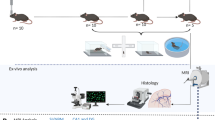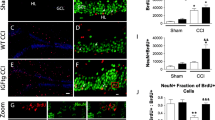Abstract
Purpose
Pediatric traumatic brain injury (TBI) represents a prominent yet understudied medical condition that can profoundly impact brain development. As the juvenile injured brain matures in the wake of neuropathological cascades during potentially critical periods, circuit alterations may explain neurological consequences, including cognitive deficits. We hypothesize that experimental brain injury in juvenile rats, with behavioral deficits that resolve, will lead to quantifiable structural changes in hippocampal neurons at chronic time points post-injury.
Methods
Controlled cortical impact (CCI), a model of focal TBI with contusion, was used to induce brain injury on post-natal day (PND) 17 juvenile rats. The histological consequence of TBI was quantified in regions of the hippocampus at post-injury day 28 (PID28) on sections stained using a variation of the Golgi-Cox staining method. Individual neuronal morphologies were digitized from the dentate gyrus (DG), CA3, and CA1 regions.
Results
Soma area in the ipsilateral injured DG and CA3 regions of the hippocampus increased significantly at PID28 in comparison to controls. In CA1, dendritic length and dendritic branching decreased significantly in comparison to controls and the contralateral hemisphere, without change in soma area. To extend the study, we examined neuronal morphology in rats with CCI at PND7. On PID28 after CCI on PND7 rats, CA1 neurons showed no injury-induced change in morphology, potentially indicating an age-dependent morphological response to injury.
Conclusions
Long-lasting structural alterations in hippocampal neurons of brain-injured PND17 juvenile animals, but not PND7 immature animals, suggest differential plasticity depending on age-at-injury, with potential consequences for later function.




Similar content being viewed by others
References
Faul M, Xu L, Wald MM, Coronado V, Dellinger AM (2010) Traumatic brain injury in the United States: national estimates of prevalence and incidence, 2002-2006. Injury Prev 16:A268
Kraus JF, Fife D, Conroy C (1987) Pediatric brain injuries: the nature, clinical course, and early outcomes in a defined United States population. Pediatrics 79:501–507
Ewing-Cobbs L, Levin HS, Fletcher JM, Miner ME, Eisenberg HM (1990) The Children’s Orientation and Amnesia Test: relationship to severity of acute head injury and to recovery of memory. Neurosurgery 27:683–691
Fletcher JM, Ewing-Cobbs L, Francis DJ, Levin HS (1995) Variability in outcomes after traumatic brain injury in children: a developmental perspective. Oxford University Press, New York
Schneier AJ, Shields BJ, Hostetler SG, Xiang H, Smith GA (2006) Incidence of pediatric traumatic brain injury and associated hospital resource utilization in the United States. Pediatrics 118:483–492
Bruce DA, Schut L, Buruno LA, Wood JH, Sutton LN (1978) Outcome following severe head injuries in children. J Neurosurg 48:679–688
Levin HS, Ewing-Cobbs L (1995) Neurobehavioral outcome of pediatric closed head injury. Oxford Univesity Press, New York
Beers SR (1992) Cognitive effects of mild head injury in children and adolescents. Neuropsychol Rev 3:281–320
Biagas KV, Grundl PD, Kochanek PM, Schiding JK, Nemoto EM (1992) Posttraumatic hyperemia in immature, mature and aged rats: autoradiographic determination of cerebral blood flow. Soc Neurosci Abstr 18:1088
Levin HS, Aldrich EF, Saydjari C, Eisenberg HM, Foulkes MA, Bellefleur M, Luerssen TG, Jane JA, Marmarou A, Marshall LF (1992) Experience of the Traumatic Coma Data Bank. Neurosurgery 31:435–443
Levin HS (1985) Outcome after head injury: general considerations and neurobehavioral recovery, Washington, D. C.
Luerssen TG, Klauber MR, Marshall LF (1988) Outcome from head injury related to patient’s age: a longitudinal prospective study of adult and pediatric head injury. J Neurosurg 68:409–416
Chauhan NB, Gatto R, Chauhan MB (2010) Neuroanatomical correlation of behavioral deficits in the CCI model of TBI. J Neurosci Methods 190:1–9
Dixon CE, Clifton GL, Lighthall JW, Yaghmai AA, Hayes RL (1991) A controlled cortical impact model of traumatic brain injury in the rat. J Neurosci Methods 39:253–262
Cherian L, Robertson CS, Contant CF Jr, Bryan RM Jr (1994) Lateral cortical impact injury in rats: cerebrovascular effects of varying depth of cortical deformation and impact velocity. J Neurotrauma 11:573–585
Donat CK, Schuhmann MU, Voigt C, Nieber K, Schliebs R, Brust P (2007) Alterations of acetylcholinesterase activity after traumatic brain injury in rats. Brain Inj: [BI] 21:1031–1037
Whalen MJ, Dalkara T, You Z, Qiu J, Bermpohl D, Mehta N, Suter B, Bhide PG, Lo EH, Ericsson M, Moskowitz MA (2008) Acute plasmalemma permeability and protracted clearance of injured cells after controlled cortical impact in mice. J Cereb Blood Flow and Metab : Off J Int Soc Cereb Blood Flow and Metab 28:490–505
Clark RS, Vagni VA, Nathaniel PD, Jenkins LW, Dixon CE, Szabo C (2007) Local administration of the poly(ADP-ribose) polymerase inhibitor INO-1001 prevents NAD + depletion and improves water maze performance after traumatic brain injury in mice. J Neurotrauma 24:1399–1405
Wagner AK, Postal BA, Darrah SD, Chen X, Khan AS (2007) Deficits in novelty exploration after controlled cortical impact. J Neurotrauma 24:1308–1320
You Z, Yang J, Takahashi K, Yager PH, Kim HH, Qin T, Stahl GL, Ezekowitz RA, Carroll MC, Whalen MJ (2007) Reduced tissue damage and improved recovery of motor function after traumatic brain injury in mice deficient in complement component C4. J Cereb Blood Flow and Metab: Off J Int Soc Cereb Blood Flow and Metab 27:1954–1964
Adelson PD, Fellows-Mayle W, Kochanek PM, Dixon CE (2013) Morris water maze function and histologic characterization of two age-at-injury experimental models of controlled cortical impact in the immature rat. Child’s Nerv Syst : ChNS : Off J Int Soc Pediatr Neurosurg 29:43–53
Prins ML, Hovda DA (2003) Developing experimental models to address traumatic brain injury in children. J Neurotrauma 20:123–137
Stevenson KL, Skinner JC, Davis DS, Tran MP, Dixon PM, Kohanek PM, Jenkins LW, Adeslon PD (2000) Behavioral dysfunction in immature rats after controlled cortical impact. J Neurotrauma 17:997
Ajao DO, Pop V, Kamper JE, Adami A, Rudobeck E, Huang L, Vlkolinsky R, Hartman RE, Ashwal S, Obenaus A, Badaut J (2012) Traumatic brain injury in young rats leads to progressive behavioral deficits coincident with altered tissue properties in adulthood. J Neurotrauma 29:2060–2074
Card JP, Santone DJ, Gluhovsky MY, Adelson PD (2005) Plastic reorganization of hippocampal and neocortical circuitry in experimental traumatic brain injury in the immature rat. J Neurotrauma 22:989–1002
Adelson PD, Dixon CE, Kochanek PM (2000) Long-term dysfunction following diffuse traumatic brain injury in the immature rat. J Neurotrauma 17:273–282
Adelson PD, Jenkins LW, Hamilton RL, Robichaud P, Tran MP, Kochanek PM (2001) Histopathologic response of the immature rat to diffuse traumatic brain injury. J Neurotrauma 18:967–976
Bittigau P, Sifringer M, Pohl D, Stadthaus D, Ishimaru M, Shimizu H, Ikeda M, Lang D, Speer A, Olney JW, Ikonomidou C (1999) Apoptotic neurodegeneration following trauma is markedly enhanced in the immature brain. Ann Neurol 45:724–735
Pohl D, Bittigau P, Ishimaru MJ, Stadthaus D, Hubner C, Olney JW, Turski L, Ikonomidou C (1999) N-Methyl-D-aspartate antagonists and apoptotic cell death triggered by head trauma in developing rat brain. Proc Natl Acad Sci U S A 96:2508–2513
Gobbel GT, Bonfield C, Carson-Walter EB, Adelson PD (2007) Diffuse alterations in synaptic protein expression following focal traumatic brain injury in the immature rat. Child’s Nerv Syst : ChNS : Off J Int Soc Pediatr Neurosurg 23:1171–1179
Adelson PD, Whalen MJ, Kochanek PM, Robichaud P, Carlos TM (1998) Blood brain barrier permeability and acute inflammation in two models of traumatic brain injury in the immature rat: a preliminary report. Acta Neurochirurgica Suppl 71:104–106
Scheibel ME, Scheibel AB (1978) The methods of Golgi. Academic, New York, pp 89–114
Scheibel ME, Crandall PH, Scheibel AB (1974) The hippocampal-dentate complex in temporal lobe epilepsy. A Golgi Study Epilepsia 15:55–80
Card JP, Santone DJ, Vanino DL, Adelson PD (2005) Cytoarchitecture of the neocortex and hippocampus following experimental traumatic brain injury in the immature rat. J Neurotrauma 22:1209
Iacono D, O’Brien R, Resnick SM, Zonderman AB, Pletnikova O, Rudow G, An Y, West MJ, Crain B, Troncoso JC (2008) Neuronal hypertrophy in asymptomatic Alzheimer disease. J Neuropathol Exp Neurol 67:578–589
Bothwell S, Meredith GE, Phillips J, Staunton H, Doherty C, Grigorenko E, Glazier S, Deadwyler SA, O’Donovan CA, Farrell M (2001) Neuronal hypertrophy in the neocortex of patients with temporal lobe epilepsy. J Neurosci 21:4789–4800
Mao H, Elkin BS, Genthikatti VV, Morrison Iii B, 3rd, Yang KH (2013) Why is CA3 more vulnerable than CA1 in experimental models of controlled cortical impact-induced brain injury? J Neurotrauma
Anderson KJ, Miller KM, Fugaccia I, Scheff SW (2005) Regional distribution of fluoro-jade B staining in the hippocampus following traumatic brain injury. Exp Neurol 193:125–130
Colicos MA, Dixon CE, Dash PK (1996) Delayed, selective neuronal death following experimental cortical impact injury in rats: possible role in memory deficits. Brain Res 739:111–119
Kim BT, Rao VL, Sailor KA, Bowen KK, Dempsey RJ (2001) Protective effects of glial cell line-derived neurotrophic factor on hippocampal neurons after traumatic brain injury in rats. J Neurosurg 95:674–679
Scheff SW, Price DA, Hicks RR, Baldwin SA, Robinson S, Brackney C (2005) Synaptogenesis in the hippocampal CA1 field following traumatic brain injury. J Neurotrauma 22:719–732
Varma MR, Dixon CE, Jackson EK, Peters GW, Melick JA, Griffith RP, Vagni VA, Clark RS, Jenkins LW, Kochanek PM (2002) Administration of adenosine receptor agonists or antagonists after controlled cortical impact in mice: effects on function and histopathology. Brain Res 951:191–201
McDonald JW, Silverstein FS, Johnston MV (1988) Neurotoxicity of N-methyl-D-aspartate is markedly enhanced in developing rat central nervous system. Brain Res 459:200–203
Ikonomidou C, Mosinger JL, Salles KS, Labruyere J, Olney JW (1989) Sensitivity of the developing rat brain to hypobaric/ischemic damage parallels sensitivity to N-methyl-aspartate neurotoxicity. J Neurosci 9:2809–2818
Maxwell WL, Povlishock JT, Graham DL (1997) A mechanistic analysis of nondisruptive axonal injury: a review. J Neurotrauma 14:419–440
Acknowledgments
The authors would like to sincerely thank the contributions of Dan Santone for the preliminary studies that made this research possible. Also, Rachel K. Rowe, PhD, Jordan L. Harrison, Jenna M. Ziebell, PhD, and the rest of the Translational Neurotrauma Research Team–Phoenix, AZ, provided thoughtful feedback on early drafts of the manuscript. These experiments were carried out at the University of Pittsburgh and analyzed and prepared for publication at the University of Arizona College of Medicine–Phoenix. This work was supported by the Walter L. Copeland Fund of the Pittsburgh Foundation Funding for Cranial Research and Phoenix Children’s Hospital Mission Support Funds.
Conflict of interest
The authors would like to disclose that there exist no conflicts of interest.
Author information
Authors and Affiliations
Corresponding author
Additional information
Eric Casella and Theresa Currier Thomas contributed equally to this paper
Rights and permissions
About this article
Cite this article
Casella, E.M., Thomas, T.C., Vanino, D.L. et al. Traumatic brain injury alters long-term hippocampal neuron morphology in juvenile, but not immature, rats. Childs Nerv Syst 30, 1333–1342 (2014). https://doi.org/10.1007/s00381-014-2446-z
Received:
Accepted:
Published:
Issue Date:
DOI: https://doi.org/10.1007/s00381-014-2446-z




